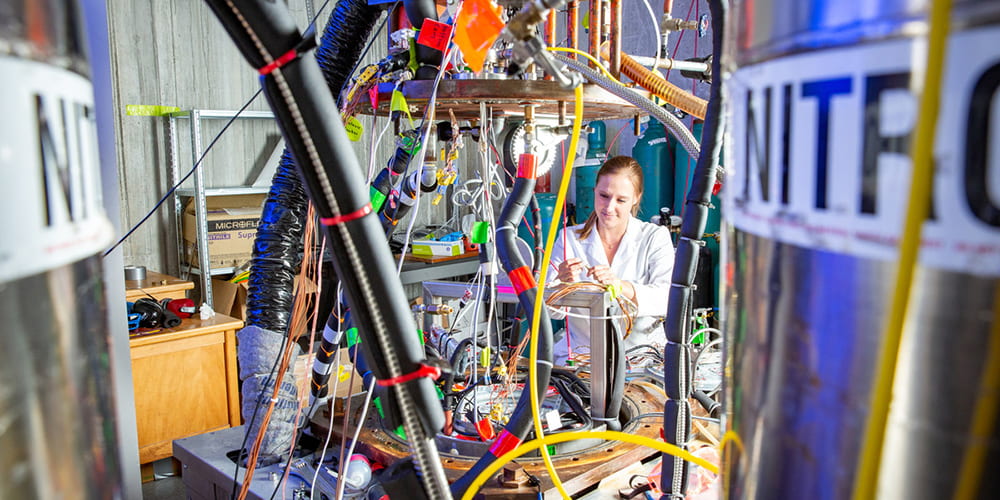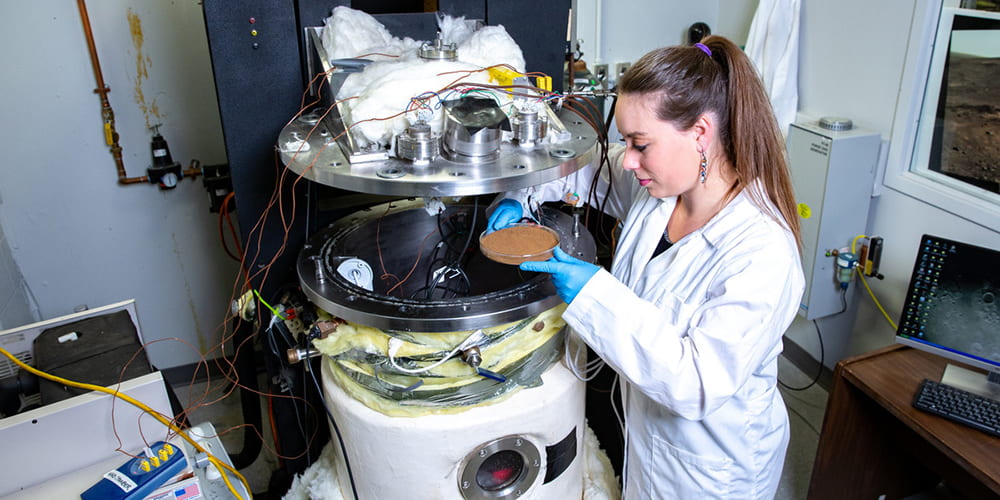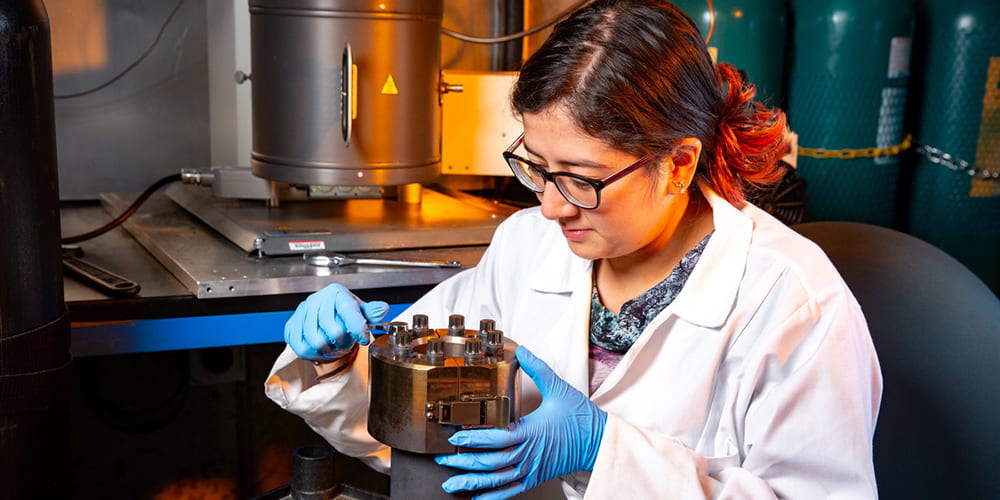Building Worlds in a Tank

Kendra Farnsworth, left, Vincent Chevrier and Ellen Czaplinski work on the Keck Lab’s Titan chamber. Photos by Russell Cothren and Whit Pruitt.
In the basement of Ferritor Hall is a windowless, bunker-like lab where researchers are building worlds dramatically unlike our own. In these worlds, entirely contained in stainless steel tanks the size of a soda can to almost two-stories tall, lakes are filled with methane instead of water, snow is metallic, carbon monoxide freezes into ice and life struggles to survive in what we’d consider lethal conditions.
The researchers building these micro worlds are studying questions such as why one planet is uninhabitable while life thrives on its virtual twin, what Earth was like before the atmosphere contained oxygen, and whether liquid water could exist in a place where it rarely gets above freezing. They look at the intersection of atmosphere and land on Mars, Venus, Pluto and Titan, Saturn’s largest moon, for answers. We can’t go to these places and dig, yet, so scientists at the W.M. Keck Laboratory for Planetary Simulations in the basement of Ferritor Hall do the next best thing: create them in the lab and see what happens.
“The goal of the lab is to simulate the surface of planets, in particular how the surface of planets evolved over time, how they interacted with their atmosphere when the atmosphere was present, and study chemical and physical conditions at the surface of planets,” said Vincent Chevrier, a research assistant professor at the Arkansas Center for Space and Planetary Sciences. “All we know of the formation and evolution of the planets is what we see on the surface.”
There’s a second goal as well, and it strays into the realm of science fiction: astrobiology. Could life exist beyond Earth, given what we know about the conditions found on other planets? And if so, what does that mean for how life began here? “We try to tie those conditions to the emergence, or lack thereof, of life on the surface of the planets,” said Chevrier. “We try to understand how that ties back to the emergence of life on Earth.”
Humble Beginnings
The W.M. Keck Laboratory for Planetary Simulations is part of the Arkansas Center for Space and Planetary Science, a multidisciplinary research center created in 2000 with a two-year, $1.6 million grant from the National Science Foundation. At the outset, it was a joint effort between the U of A and Oklahoma State University, designed to create a critical mass of researchers and facilities to contribute to NASA’s ongoing program of robotic space exploration. It has evolved into an interdisciplinary program among seven U of A departments, three colleges, and the Graduate School and International Education and it offers graduate degrees in space and planetary sciences, biology, geology and physics.
The Keck Lab, home to the five simulation tanks, got its start in 2004 with a $500,000 challenge grant from the W.M. Keck Foundation of Los Angeles to then-Space Center director and chemistry professor Derek Sears to study water on Mars. Sears already had Keck’s centerpiece in his lab: the Andromeda chamber, a two-meter tall vessel acquired from NASA’s Jet Propulsion Laboratory in Pasadena, Calif., when the Center for Space and Planetary Science opened. Back then, the Keck Lab and the Andromeda chamber were housed in the basement of the Field House, now known as the Faulkner Center for Performing Arts.
Five Chambers, Four Planets
At first the Andromeda chamber was dedicated to the study of water on Mars; how it evaporates, how it behaves as ice, how it forms brines. Chevrier has since repurposed it to study the cold, atmospherically dense surface of Titan, Saturn’s largest moon.

Kendra Farnsworth works on the Titan Chamber, which is open for maintenance. Farnsworth is studying how hydrocarbons freeze at conditions similar to those on Titan.
Titan is the only planetary body in the solar system besides Earth known to have rain-fed rivers, lakes and seas. The liquid isn’t water, though; At minus 290 degrees Fahrenheit, it’s far too cold for that. Still, there are parallels between Earth and Titan that interest scientists. Titan’s atmosphere is primarily nitrogen, for example, which makes it similar to Earth’s atmosphere before photosynthesis added oxygen to the mix.
“There are hypotheses that before life emerged on Earth its atmosphere was relatively similar to Titan,” said Chevrier. “Therefore understanding the biochemistry and the chemistry happening in the atmosphere and at the surface of Titan could help us understand the prebiotic chemistry on Earth and how it could have then evolved to life on Earth because of the much higher temperature.”
The Keck Lab has two chambers devoted to the surface of Mars: one for studying the possibility that liquid water exists there, and one for determining if any organism is tough enough to survive there.
Mars’ atmosphere is thin and very cold, so if liquid water exists at the surface it would likely be in tiny amounts and suspended in a brine solution that acts like antifreeze, says Chevrier. Researchers focus on creating Mars-like conditions in one of the tanks, then determining if brines are stable, or if they evaporate or freeze. They’ve had some luck with brines containing ferric sulfate and perchlorates, but Chevrier is skeptical that there is liquid water in any significant quantity on Mars.

“Where should we look and what instrument should we use?” he said. “We are not talking about a pond of water. We are talking about minute droplets, sub-millimeter size, in an ocean of regolith (rocky material).”
The case for life on Mars is stronger. While researchers can’t say life exists there, findings based on Keck Lab research indicate that it could. Researchers subjected methanogens – methane-producing organisms that are common on Earth and able thrive in harsh environments such as geothermal sea floor vents and Arctic permafrost – to Mars-like temperatures and found that some species did survive.
The Pluto chamber is a bit larger than a beer keg, though you wouldn’t mistake it for one. Ports on the sides and top are sealed with sturdy bolts that hint at the pressure and temperature extremes the chamber is built to contain.
NASA’S New Horizons spacecraft, launched in January 2006, flew by Pluto in July 2015 and provided scientists with their first real glimpse of the dwarf planet. High-resolution photos and spectroscopy revealed a world of ices composed of methane, nitrogen and carbon monoxide. NASA measured the atmospheric pressure on Pluto by sending carefully timed radio waves from Earth, through Pluto’s atmosphere and to the New Horizons spacecraft, then calculating how much the waves refracted, or were bent. Pluto’s atmospheric pressure, they discovered, is 100,000 times lower than on Earth.


With those parameters in hand, Keck lab researchers recreated surface conditions on Pluto and are studying the chemical composition of its ices. “It’s astounding the ices we can observe on Pluto, and they’re actually very common,” said Caitlin Ahrens, a doctoral candidate and the Pluto lab manager. “It’s methane, nitrogen, carbon monoxide, water ice. But knowing how they mix together, how do they behave? Do they become completely solid together? Do they become chunky? Do they become glassy? That is still unknown to us, so we can simulate Pluto conditions in the lab and try to mix together these ices and see what happens.”
The Venus chamber is the Keck Lab’s smallest – about the size of a soda can – and most volatile. It’s housed in a different room away from the other tanks because of the pressure and temperatures involved.
“It is 100 times the pressure on earth and 500 degrees Celsius,” said Chevrier. “You have to be very careful with that one.” Venus is perpetually shrouded in clouds, but the surface has been extensively mapped by radar, and the results show something interesting. “The radar signal becomes anomalously bright at high altitude, Like a Christmas tree,” Chevrier said. “Nobody knows why.”
On Earth, high altitude correlates to the snow line. But it’s far too hot for snow on Venus; unless the snow isn’t water. “It needs to be something semi-conductive to explain the radar results,” said Chevrier.
To try to understand this, researchers study compounds of bismuth tellurium, sulfur, iron, lead and mercury, metals volatile enough to be ejected from a volcano and descend on the mountaintops as metallic deposits.
Though Venus and Earth are very different planets today, they were once similar, said Chevrier, and therein lies a cautionary tale. “The idea is to understand what went wrong on Venus,” he says. “What happened sometime in the past of Venus that made it like that today? Because a runaway greenhouse, when you pass a certain point in the climate evolution that you cannot reverse the effect, you are doomed. We look at Venus so we don’t do the same on Earth.”
Hands On
Many students interested in planetary sciences find themselves working with mission data gathered by NASA, the European Space Agency and other sources. It’s a rich source of information easily accessible online, and it offers a way into important questions.
But mission data only takes researchers so far. It’s a snapshot. To explore deeper questions about processes and evolution requires experimentation. And that is why the Keck Lab is vital, Chevrier said. It not only allows researchers to use mission data as a starting point to answer questions about how the universe works, it offers them hands-on engineering challenges in designing and building the simulators. That focus on experimentation, Chevrier said, helps attract students who “want to get their hands dirty.”
“I am fairly capable of attracting top students who could easily be accepted in top institutions in planetary science. It is small, bit it is a very good program. From the experimental perspective, we are one of the best.”

